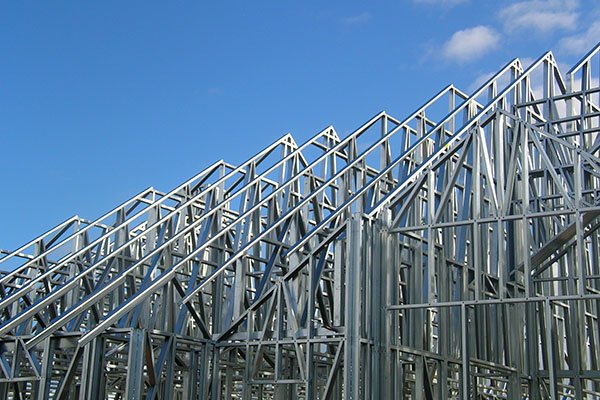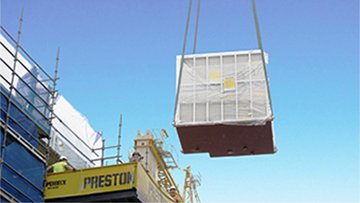10 Reasons to shift to steel for framing
With timber prices through the roof and availability limited, there has never been a better time to switch to steel for construction. You may be surprised at how easy it can be, and you will find the benefits go beyond the short term. Here are 10 reasons why shifting to light gauge steel will earn you a competitive advantage.
 |
 |
If you are leading a Kiwi construction business that is framing up the way you have always done it - with timber – you may have been experiencing a few challenges recently with availability and price hikes. If that sounds like you, now could be the perfect time to realise the benefits of light gauge steel.
Those builders that have already made the shift to light steel framing using offsite and modular construction techniques may have stolen a bit of an advantage. But all is not lost!
You may be surprised at how easy it can be to transition to construction with light gauge steel (LGS). For those that make the effort, the benefits are numerous. At the basic level, you will find you can start to deliver projects faster (even when availability is back to normal), which will help keep customers happy, potentially secure performance bonuses and help you gain more projects.
With efficiency improvements, you will see far less wastage so your costs will be lower. Thanks to improved accuracy, your team will experience minimal re-work requirements or call backs, which adds to project profitability. And with LGS weighing in at less than a third of the weight of timber used for framing, you may find your team are grateful for the change too.
Steel vs Timber: 10 reasons why you should be building with steel.
The benefits of steel construction are significant. To get things rolling along, we have put together this comparison so people in the business can make a judgement call on how light steel construction weighs up against timber framing from a builder’s perspective. Note - You can also find a printable leaflet with all of this information here.
1. Steel construction: The fastest, most efficient option
Light steel framing is manufactured using steel roll forming machines that deliver pinpoint precision. This means that all framing components are dimensionally accurate. The result is minimal rework. With more accurate construction methods, you get faster build times.
You will also discover other efficiencies. Offsite panelised framing enables pre-assembled steel packages to be delivered and lifted straight from the truck in sequence. That means greater build efficiency on site too.
For example, one of New Zealand’s large group builders decided to make the transition to LGS with our sister company Howick Limited. The results were so good, they have never looked back.
2. Steel wastage is up to 10x less than timber
Based on a US study, typical timber construction wastage is about 20%. With light gauge steel, wastage is just 2% - a ten-fold reduction, which adds up to considerable cost savings. SCI Studies proved that waste reductions of up to 70% are possible with off-site light steel modular construction.
With less wastage and more efficiency throughout the process, pricing can be sharper, so construction businesses can pass that benefit on to customers as reduced costs or increase their margins as they see fit.
3. Steel: The environmental benefits of being 100% recyclable
It is not just reduced wastage that is important, it is the environmental impact of what happens to waste. Unlike treated timber, steel is 100% recyclable.
When it comes to factory production, all steel off-cuts are recycled. Steel can be used time and time again, without losing any of its structural integrity or performance properties. Globally the steel industry reports a 66% recycling rate. Even with demolition jobs, 85% of steel is recycled.
Finally, because light gauge steel weighs less than timber, transportation is easier, more efficient and lower cost too.
4. Light gauge steel is the lightweight high strength alternative to timber
Interpod move modular light steel bathrooms into place in Australia.
Timber used in framing construction weighs three times more than its thin-guage, high-tensile steel equivalent. Because it is lighter, LGS is safer and easier to move around on site, and transportation costs less. And of course, lighter weight does not come at the expense of strength. In fact, LGS offers the highest strength to weight ratio of any framing material. Self-drilling screws and glue are used instead of nails for skirtings, architraves and fixtures. There is no shrinkage and no more popping nails means stronger, more durable connections.
All up, steel framing provides a lighter structure with stronger connections, which means great earthquake and wind load strength that meets even the toughest seismic rating requirements.
5. Price benefits of steel over timber
Timber and steel in general terms are similarly priced, and while there are many factors to material pricing (volume discounts and design requirements among them), framing cost differentials on a like-by-like basis are in all probability similar.
There is no impact on the cost of building consents either, since consent processes are determined by the cost of the build, not the materials used.
However, there are many pricing advantages to steel over timber that may help secure more profitable projects:
- Steel framing is significantly faster to construct, so resource costs for labour are reduced
- The improved accuracy of light-gauge steel framing manufacture means less re-work, less call-backs and less wastage, all impacting final costs
- Over the longer term, steel framing remains straight and true. This means less issues with cracking to plaster linings and other fixtures and fittings over time, so the cost of ownership is reduced.
6. Steel is surprisingly easy to work with
Many people tied into traditional construction believe it is easy to work with wood and finding trained builders and hammer hands is easy.
However, this is simply an industry myth. Many builders who have worked with timber all their lives find it surprisingly easy to switch to LGS. What is more, it is now an integral part of every good carpenter's training.
7. Steel framed houses look just like timber framed houses, yet they are more durable
There are no restrictions on the type of cladding that can be used with steel framing and the finished houses look exactly like their timber alternatives. Indeed, even when architects design in timber, because most steel frames are made to the same dimensions as their timber alternatives, steel can be used instead.
Steel also offers better long-term durability on a number of levels, not least of which is lower condensation.
8. Steel offers improved condensation performance over timber, increasing durability
Because steel has a high degree of thermal conductivity, thermal bridging is used in construction. This allows steel framing inside the thermal bridging to remain above the temperature that condensation forms in the wall cavity. This protects studs and wall linings.
With timber studs however, condensation is attracted during winter months increasing the moisture content in the building irrespective of the cladding used. This damages the linings and compromises the longer-term durability of timber framing.
Timber has a residual water content of 10-18%, so over time there are issues with mould and wood rot, even with treated timber. Unlike timber, however, steel does not absorb water, so it cannot promote mould, making for healthier homes in the long run.
It also means zero issues with the dimensional changes so common with timber framing. Light gauge steel framing stays straight and true, irrespective of age.
9. Steel buildings offer big advantages in fires
Steel's improved fire rating is another advantage of steel construction.
Electrical faults are the most common cause of fires in wall cavities, but they cannot ignite steel framing. Steel is non-combustible, so when a fire does burn through wall linings, it will not spread within the framing cavity.
The fire load of a building is a measure of how intensely it would burn if a fire should break out. A higher fire load equals a more destructive fire. Fortunately, steel does not increase the fire loading of a building. However, timber is combustible with at least 20kg per square metre of floor area in a typical timber framed house. That is 75% of the total fire load, meaning that a timber house has at least a 1.75 times greater fire load*.
Should a fire break out in a steel framed house, so long as the framing is not visibly distorted, it can be cleaned, left in place and recoated if necessary. It does not need to be replaced.
That all adds up to a pretty reassuring situation for the owners of steel framed buildings, particularly in fire-prone regions of the country.
10. 60 years of steel construction and counting
Of course, many trust timber simply because people have always built with it… Well, that is true, but older timber houses were constructed with heart timber, and clad in building paper with roof and wall cavities to create space for the timber to breathe.
Most modern timber homes today are built with younger Pinus Radiata, which is less durable. Walls these days tend to be highly insulated too, so airflow is restricted. As a result, cladding and building wraps employed now do not protect against condensation in the same way.
Light gauge steel construction has been tried and tested for decades now, and has truly stood the test of time. In residential and commercial construction, it has been used successfully for over 60 years.
Steel is more durable than timber. And as we have seen, with steel there is no water absorption and there are no dimensional changes, so it does not cause gypsum board linings and plaster work to buckle or crack.
A global trend taking hold in New Zealand
The trend towards steel has been gathering momentum for many years. Today steel construction accounts for 40% of all building in Hawaii alone. In Japan, over 150,000 steel framed homes are built every year. In Australia, 15% of all new houses are light gauge steel framed, and in South Australia, it is now more than 30%. New Zealand has always been at the forefront of manufacturing LGS roll-forming technology for export markets. Now, with timber shortages and price challenges hitting hard, the benefits of steel are being realised by more and more Kiwi builders.
Time to re-think your framing options? Shift to steel today.
All up, steel framed homes are more durable, stronger and faster to build. The advantages are manyfold. Is it time to put yourself in the frame for light gauge steel? To make the switch, talk to us today.
*Source: National Association of Steel Framed Housing (NASH) https://www.nash.asn.au/nash/
Get in touch
We encourage you to furnish us with as much detail as possible.
That way we can assist you with the best solutions based on your requirements quickly.


